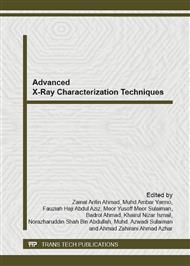p.213
p.219
p.224
p.230
p.236
p.241
p.246
p.252
p.257
Hybrid Multiwalled Carbon Nanotubes/Minerals as Potential Fillers for Polymer Composites
Abstract:
Minerals are always used as filler material in polymer composite application purposely to reduce the price. In order to optimize the use of mineral fillers instead of price reduction, there were several approaches that have been done such as surface treatment, finding suitable coupling agent, and etc. The study on hybridization of minerals with carbon nanotubes (CNT) are rare to be found. CNT has received great attention from researchers due to their superior properties to be used in many applications. Hybridizing CNT with minerals proposes potential fillers for polymer composite. In this study, chemical vapor deposition (CVD) technique was used to synthesize the CNT-minerals hybrid compound. A mixture of CH4/N2 was used as the carbon source and nickel as the metal catalyst for the growth of CNT hybrid compound. Three different types of minerals were used namely talc, muscovite and CaCO3 are used to synthesize the MWCNT-talc, MWCNT-muscovite and MWCNT-CaCO3 hybrid compound. In short, the process involved precipitation of mineral filler with nickel salt. The process was followed by calcinations and reduction of the catalyst, and methane decomposition. The produced hybrid compounds were then analyzed.
Info:
Periodical:
Pages:
236-240
Citation:
Online since:
December 2012
Keywords:
Price:
Сopyright:
© 2013 Trans Tech Publications Ltd. All Rights Reserved
Share:
Citation:


